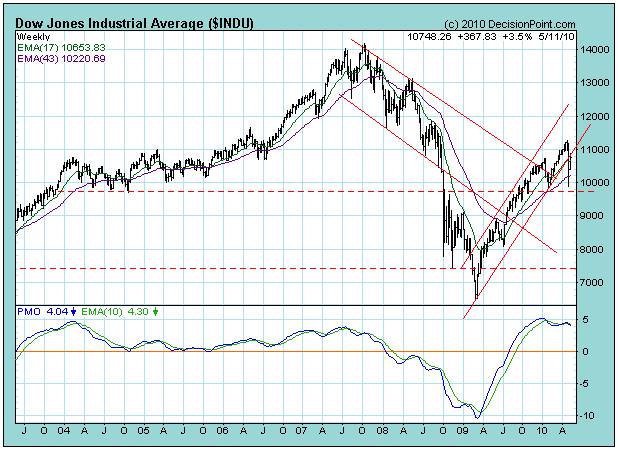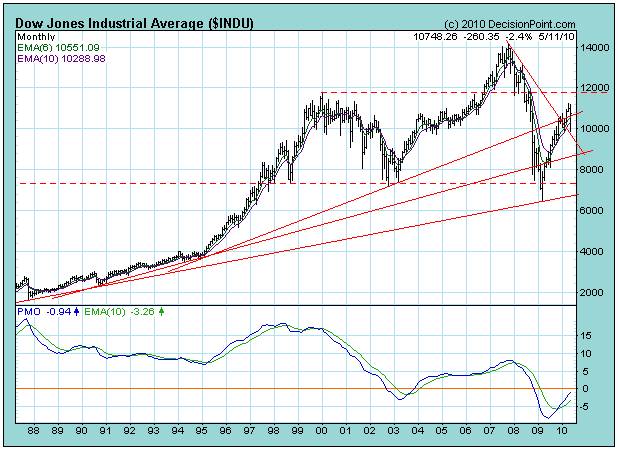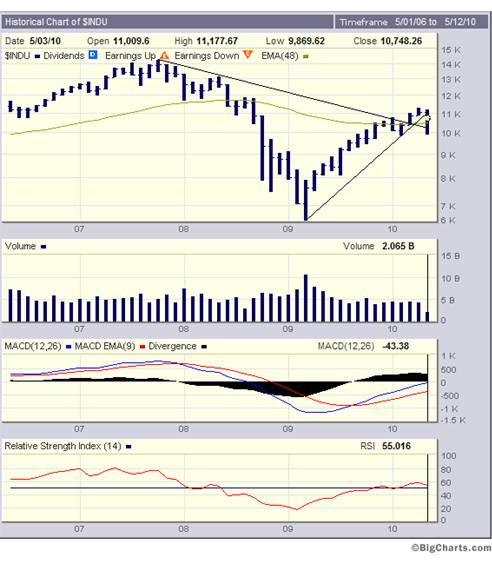Stock Market Trading Brave or Stupid?
Stock-Markets / Stock Markets 2010 May 12, 2010 - 03:52 AM GMTBy: Brian_Bloom
 Two thirds of all trading on the NYSE is algorithm trading by hedge funds – some, with advance information because of the location of their computers – effectively trading as quasi insiders. Timing is in seconds. To understand what is happening we need to stand back to see the “Secondary” and “Primary” trends.
Two thirds of all trading on the NYSE is algorithm trading by hedge funds – some, with advance information because of the location of their computers – effectively trading as quasi insiders. Timing is in seconds. To understand what is happening we need to stand back to see the “Secondary” and “Primary” trends.
Secondary: Chart 1 – Weekly chart of the Dow Jones (courtesy, DecisionPoint.com)

- Price broke down below the lower support of a rising wedge towards the end of 2009.
- This was accompanied by a sell signal on the PMO
- Price subsequently rose above the high of the rising wedge but stayed below resistance of the upper boundary
- PMO DID NOT RISE TO A HIGHER HIGH - - ie There was a Technical Non Confirmation
- The crash took the index to below the level of now adjusted lower trend line and PMO gave a second sell signal
- 9,800 now represents technical support level
Conclusion:
Technical Non Confirmations and Confirmations are critically important
2. Primary: Monthly Dow Jones (Courtesy, DecisionPoint.com)

- PMO gave a buy signal towards the end of 2009
- This is probably what caused the euphoria and this, in turn, caused the price on the weekly chart to rise back above the top of the rising wedge.
- Note the falling tops and falling bottoms on the PMO. This is not bullish
- The market is probably no longer in a Primary Bull Trend but may experience a prolonged (years) trading range rather than a collapse back to the 4000 level
Chart 3: Courtesy BigCharts.com (Log scale)

- Whilst the index is above its 48 month MA and above the falling trend line, it is below the rising trend line
- Volume has been anemic since the beginning of 2010
- MACD looking toppy
- RS pointing down
- This chart confirms that the Primary Trend is probably no longer bullish
Conclusions
- “Investment” should only be in special situations which have strong underlying fundamentals and long term patience.
- “Trading” should be avoided like the plague. You are up against mainframe computers in an environment where there are vested interests trying to “manage” the trends.
- If you do not understand fundamentals, then make damned sure that you are investing “with the trend”.
Fundamentally, the following information is relevant:
- US Public Debt is trending towards 100% of GDP.
- US unemployment – adjusted for under employed – is around 17.1%
- US velocity of money is falling because personal savings rates are rising
One could argue (and many are) that when there is blood in the streets, its time to invest. When things look blackest, it can’t get any worse.
But things could get a lot worse. P/E ratios in the US are at levels which are more consistent with Bull Market Tops than Bear Market bottoms. (Source: Decionpoint.com)
Est Est Est Est
2009 Q4 2010 Q1 2010 Q2 2010 Q3 2010 Q4
TMT P/E Ratio (GAAP).......: 22.70 19.00 18.40 17.90 17.70
TMT P/E Ratio (Operating)..: 20.30 17.60 16.20 15.10 14.30
TMT Earnings (GAAP)........: 50.97 60.83 62.96 64.53 65.37
TMT Earnings (Operating)...: 56.86 65.63 71.42 76.34 81.06
QTRLY Earnings (GAAP)......: 15.18 17.38 15.64 16.33 16.02
QTRLY Earnings (Operating).: 17.16 18.88 19.60 20.70 21.88
Rising profits in the past 12 months have been facilitated more by cost cutting than by growth as revenue lines have largely flattened or contracted slightly.
But now that cost cutting has been implemented, the only way for profits to rise will be if revenues rise.
It follows that forecast earnings (as per above) are probably based on the core underlying assumption that revenue will rise.
It would be prudent to validate the assumption that underlying revenues will grow. What will “drive” rising revenue in the USA if Europe is a basket case? Exports to Asia? Growing employment in the USA?
A rising dollar will cause a bigger US deficit and lower industrial activity in the US. A falling dollar will drive US inflation.
Conclusions
- Best case scenario based on fundamentals: If the authorities are able to hold the line, they can avoid a collapse but we will probably see a sideways movement in share prices are slowly rising earnings grow to reduce P/E ratios to around 10-12X
- Base case scenario based on fundamentals: US GDP growth remains barely positive in real terms (ie volumes remain flat). Bear Market continues and prices head south
- Worst case scenario: Market collapse
Why won’t revenues grow?
Two reasons:
- Because the US consumer drives 70% of GDP and, with high unemployment, the US Government, funded by borrowings, has been driving GDP at the margin. This has caused debt levels to blow out and the Senate is now talking about “no more bailouts”
- Because Europe is taking on an additional trillion dollars in debt and, between them, the US and the EU account for over half the world’s GDP. The tail (BRIC countries) cannot wave the dog.
Overall Conclusion
If “the trend is your friend” you need to recognize that the “Primary Trend” is probably edging towards becoming bearish. It is foolhardy to try to trade by “buying” stocks under such circumstances. Further, it should be recognized that “selling short” will be selling into a situation which the authorities are trying to avoid. You are trying to beat City Hall. No one should fight City Hall; especially if the hedge funds are standing ahead of you in the queue. It’s a no win situation.
So how does one make money in this environment?
Look for special situations which seem likely to become strong payers of dividends and have patience. Industries:
- Energy and energy infrastructure (but not “bleeding edge” technology)
- Medical technologies that can reduce health costs
- Transport infrastructure
- Water
- Agriculture, agronomy.
- Gold – as an insurance policy to protect against erosion of the value of your capital base.
Make sure, fundamentally, that your special situation” investments are adequately capitalized to enable the projected dividends to become possible. You will probably be unable to exit these investments in a Primary Bear Market. Undercapitalized companies will battle to recapitalize in a Primary Bear market
By Brian Bloom
Once in a while a book comes along that ‘nails’ the issues of our times. Brian Bloom has demonstrated an uncanny ability to predict world events, sometimes even before they are on the media radar. First he predicted the world financial crisis and its timing, then the increasing controversies regarding the causes of climate change. Next will be a dawning understanding that humanity must embrace radically new thought paradigms with regard to energy, or face extinction.
Via the medium of its lighthearted and entertaining storyline, Beyond Neanderthal highlights the common links between Christianity, Judaism, Islam, Hinduism and Taoism and draws attention to an alternative energy source known to the Ancients. How was this common knowledge lost? Have ego and testosterone befuddled our thought processes? The Muslim population is now approaching 1.6 billion across the planet. The clash of civilizations between Judeo-Christians and Muslims is heightening. Is there a peaceful way to diffuse this situation or will ego and testosterone get in the way of that too? Beyond Neanderthal makes the case for a possible way forward on both the energy and the clash of civilizations fronts.
Copies of Beyond Neanderthal may be ordered via www.beyondneanderthal.com or from Amazon
Copyright © 2010 Brian Bloom - All Rights Reserved
Disclaimer: The above is a matter of opinion provided for general information purposes only and is not intended as investment advice. Information and analysis above are derived from sources and utilising methods believed to be reliable, but we cannot accept responsibility for any losses you may incur as a result of this analysis. Individuals should consult with their personal financial advisors.
Brian Bloom Archive |
© 2005-2022 http://www.MarketOracle.co.uk - The Market Oracle is a FREE Daily Financial Markets Analysis & Forecasting online publication.



